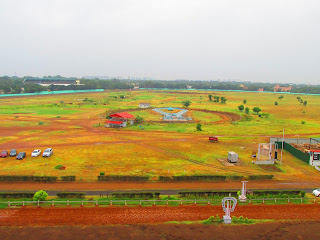Madras Race Club
Guindy, located within the bustling city of Chennai, is a hub of activity with millions of daily commuters passing through. At the heart of this vibrant area stands the Guindy suburban railway station, a pivotal transportation hub. Surprisingly, many frequent visitors to Guindy may remain unaware of the expansive Guindy Race Course situated in close proximity to the busy railway station and bus terminal. Only those who actively follow and partake in horse racing or have deep-rooted ties to the area are likely acquainted with the Guindy Race Course, which happens to be India's oldest.
 The origins of this race course trace back to 1777 CE when lands from the Velachery and Venkatapuram villages were designated for horse racing purposes, long before the official establishment of the club in 1837 CE. The course's history has been far from seamless. Racing events were irregular in the early years and even halted briefly during the threat of Hyder Ali's invasion of Madras. It wasn't until the formation of the club that regular racing resumed until 1875 CE. Subsequently, the establishment of the Madras Race Club in 1887 CE led to a resurgence in the course's popularity.
The origins of this race course trace back to 1777 CE when lands from the Velachery and Venkatapuram villages were designated for horse racing purposes, long before the official establishment of the club in 1837 CE. The course's history has been far from seamless. Racing events were irregular in the early years and even halted briefly during the threat of Hyder Ali's invasion of Madras. It wasn't until the formation of the club that regular racing resumed until 1875 CE. Subsequently, the establishment of the Madras Race Club in 1887 CE led to a resurgence in the course's popularity.

Happy travelling.
 The origins of this race course trace back to 1777 CE when lands from the Velachery and Venkatapuram villages were designated for horse racing purposes, long before the official establishment of the club in 1837 CE. The course's history has been far from seamless. Racing events were irregular in the early years and even halted briefly during the threat of Hyder Ali's invasion of Madras. It wasn't until the formation of the club that regular racing resumed until 1875 CE. Subsequently, the establishment of the Madras Race Club in 1887 CE led to a resurgence in the course's popularity.
The origins of this race course trace back to 1777 CE when lands from the Velachery and Venkatapuram villages were designated for horse racing purposes, long before the official establishment of the club in 1837 CE. The course's history has been far from seamless. Racing events were irregular in the early years and even halted briefly during the threat of Hyder Ali's invasion of Madras. It wasn't until the formation of the club that regular racing resumed until 1875 CE. Subsequently, the establishment of the Madras Race Club in 1887 CE led to a resurgence in the course's popularity.Despite facing interruptions due to World War I, the Race Course regained stability under the patronage of Lord Willingdon in 1933 CE, with the construction of the Guindy Lodge. Even after India's independence, the Race Course encountered numerous challenges. A horse racing ban in the 1970s and government control of the club in the 1980s tested its resilience.
Sri M.A.M. Ramaswamy, an industrialist who passed away in 2015 CE, played a pivotal role in the post-independence era of the Madras Race Club. He tirelessly supported the club through legal battles, ensuring its continuity amidst adversity. Ramaswamy's deep passion for horse racing led him to own approximately 1,000 horses at one point, a remarkable achievement recognized by Guinness World Records.
Today, the club boasts a stable of over 600 horses, with racing events occurring exclusively during a four-month window from November to March. However, the club remains a year-round gathering spot, thanks to large TV screens that allow patrons to purchase tickets and place bets on races happening in other cities, as well as watch live broadcasts.
So, whether you're a racing enthusiast or simply curious, a visit to Guindy Race Course promises a unique and exciting experience.

Happy travelling.




.JPG)
Comments
Post a Comment